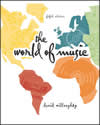|
 |  The World of Music, 5/e David Willoughby
American Folk Music Traditions
Chapter 4:
| Nature of folk music | Authentic folk music is understood by a community of participants within a cultural group. The music reflects the spirit and personality of the people who product it, use it, and value it. It grows spontaneously out of the lives of the people and conveys in song their joys and sorrows, relationships and romances, and events and circumstances that are important to them. Folk music is primarily a vocal genre, with melodies that are easily singable. Regular patterns, balance, repetition, and predictability are typical.
|  |  |  | | Types of American folk songs and dances | The different types of American folk songs are narrative ballads, broadsides, lyric songs, work songs, children’s songs, rally and protest songs, spirituals, and blues songs. Instrumental dance music is a vital part of traditional folk music.
|  |  |  | | Oral tradition | Music learned and passed down by word of mouth as opposed to that which is conveyed in writing.
|  |  |  | | Field recording | A scholarly or professional recording of fold or traditional music made in the environment where the performers typically make music, rather than in a professional recording studio.
|  |  |  | | Preserving and dissemination | A significant impetus for this broadening of the sources of folk music was and continues to be the thousands of concerts and festivals of folk, bluegrass, and jazz festivals that take place each year. A revival of folk music began in 1958. By the early 1960s, recordings of folk songs and songs composed in the manner of folk songs became an important part of the music industry and popular culture. Newsletters, magazines, books, and radio shows were devoted to this new folk music. That was the typical popular music environment of the early 1960s.
|  |  |  | | Traditional music | Traditional folk music is created anonymously, learned through the process of oral tradition, and performed by amateurs in nonprofessional settings.
|  |  |  | | Spirituals | A religious song usually of a deeply emotional character that was developed especially among African Americans in the Southern United States.
Blues – A style of music that has exerted considerable influence on jazz, rhythm and blues, soul, rock, and other forms of recent American popular music. Blues can refer to a three-line poetic stanza, a 12-bar musical structure with a specific chord progression, a scale having the flatted blues notes, or a melancholy, soulful feeling.
|  |  |  | | Ethnic music | In the United States, immigrants brought their own folk songs and dances. As they assimilated, they allowed composed folk music and music borrowed from other American subcultures to become their own. This too place with the music and dances of French Canadians, Mexican Americans, Puerto Ricans, Polish and Italian immigrants who created urban ethnic neighborhoods.
|  |  |  | | Folk revivals | A revival is a resurgence or a return to popularity of a previously existing, perhaps once popular, genre. Examples of revival genres include ragtime, klezmer, Native American songs and dances, and folk music in the United States and elsewhere. A revival usually involves the interest and participation of performers outside the tradition that originally produced the genre.
|  |  |  | | Contemporary folk | Contemporary folk music takes on different forms such as urban blues or rhythm and blues. Blues bands are currently popular; they are heard regularly at blues festivals and at clubs and community events in almost any city.
|
|
|



 2003 McGraw-Hill Higher Education
2003 McGraw-Hill Higher Education